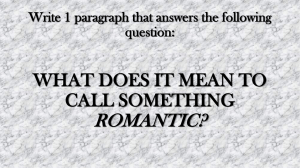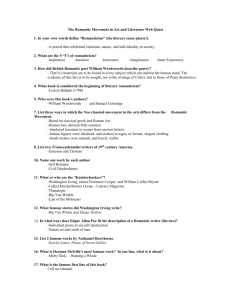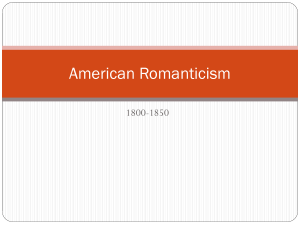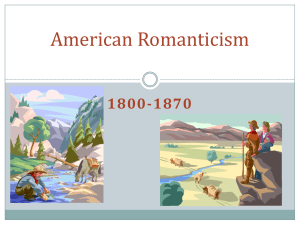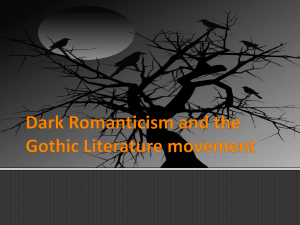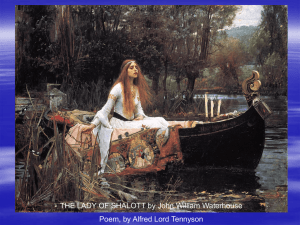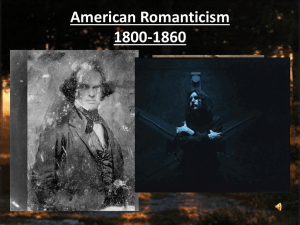File - The Romantics
advertisement
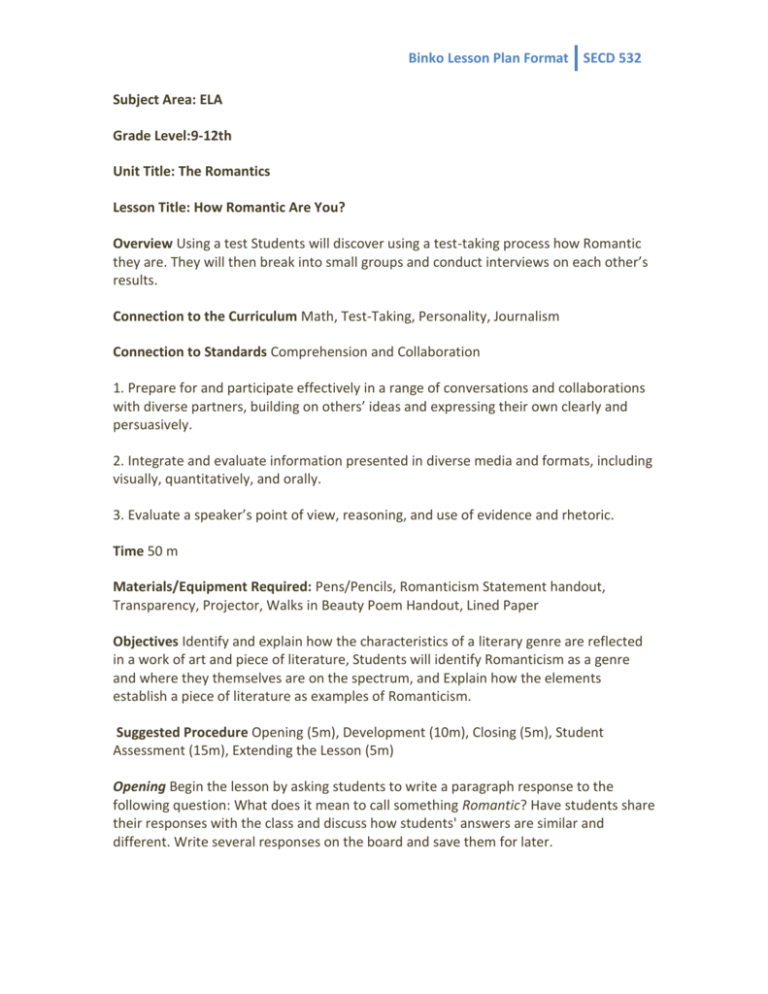
Binko Lesson Plan Format SECD 532 Subject Area: ELA Grade Level:9-12th Unit Title: The Romantics Lesson Title: How Romantic Are You? Overview Using a test Students will discover using a test-taking process how Romantic they are. They will then break into small groups and conduct interviews on each other’s results. Connection to the Curriculum Math, Test-Taking, Personality, Journalism Connection to Standards Comprehension and Collaboration 1. Prepare for and participate effectively in a range of conversations and collaborations with diverse partners, building on others’ ideas and expressing their own clearly and persuasively. 2. Integrate and evaluate information presented in diverse media and formats, including visually, quantitatively, and orally. 3. Evaluate a speaker’s point of view, reasoning, and use of evidence and rhetoric. Time 50 m Materials/Equipment Required: Pens/Pencils, Romanticism Statement handout, Transparency, Projector, Walks in Beauty Poem Handout, Lined Paper Objectives Identify and explain how the characteristics of a literary genre are reflected in a work of art and piece of literature, Students will identify Romanticism as a genre and where they themselves are on the spectrum, and Explain how the elements establish a piece of literature as examples of Romanticism. Suggested Procedure Opening (5m), Development (10m), Closing (5m), Student Assessment (15m), Extending the Lesson (5m) Opening Begin the lesson by asking students to write a paragraph response to the following question: What does it mean to call something Romantic? Have students share their responses with the class and discuss how students' answers are similar and different. Write several responses on the board and save them for later. Development Display a transparency of the Romanticism Statements (see accompanying sheet), and as you read through them, have students indicate on a sheet of paper whether they personally agree or disagree with each statement by recording "A" for agree or "D" for disagree. After all students have read and responded to the questions, ask them to total all of their As and Ds. Then have students determine how "Romantic" they are by sharing the following key: 3 or fewer As = "not Romantic" 4 or 5 As = "sort of Romantic" 6 or 7 As = "highly Romantic" 8-10 As = "extremely Romantic" Closing As the teacher, take the test yourself then share your results with the students. Have them ask questions regarding their understanding of the test process. Student Assessment Explain to students that each of the statements contains a Romantic literary characteristic written in the affirmative. Ask students to review the paragraphs they wrote in step one. Then have students break into small groups of three to five students. In their groups, have students conduct mock-interviews explaining how their understanding of the term Romanticism has changed after taking the quiz. How has your understanding of Romanticism changed? Briefly describe your definition of Romantic. How is your definition of Romantic similar to and different from Romanticism? Strategies to Differentiate Instruction Have the ELL/SPED students partner up with a mainstream or Gifted/Talented student to either/or take the test and discuss results and how their understanding has changed. Extending the Lesson Read She Walks in Beauty by Lord Byron and rate it on the Romanticism scale. As a class, discuss the differences of opinion among the students. Additional Resources ThinkQuest for Students by Students The Romantic Era http://library.thinkquest.org/15413/history/history-rom.htm Binko Lesson Plan Format SECD 532 Statements that Embody or Suggest Romanticism 1. The answers to life’s most puzzling questions can be found through discussions with a simple person who lives in the country close to nature— not with a sophisticated, well-educated person from the city. 2. The answer to life’s most puzzling questions can be found through a connection with nature. 3. The use of one’s imagination is more important than rational thought. 4. Subjectivity is more important than objectivity. 5. Knowledge is gained through gut reactions and subjective hunches rather than level-headed, objective, deductive thought. 6. Nature is more important than art. 7. Experimental trial and error is a better process than the conventional scientific method. 8. Poetry should be spontaneous and full of emotion, not planned and straightforward. 9. Sensitivity, feelings, and spontaneity are more important than intellectualism. 10. “Dare to be” is a better battle-cry than “dare to know.” Name_______________ Date__________ Pd_______ Rate on the Romanticism Scale 3 or fewer As = "not Romantic" 4 or 5 As = "sort of Romantic" 6 or 7 As = "highly Romantic" 8-10 As = "extremely Romantic" How many As does the Poem Get? And Why? She Walks in Beauty By Lord Byron (George Gordon) She walks in beauty, like the night Of cloudless climes and starry skies; And all that’s best of dark and bright Meet in her aspect and her eyes; Thus mellowed to that tender light Which heaven to gaudy day denies. One shade the more, one ray the less, Had half impaired the nameless grace Which waves in every raven tress, Or softly lightens o’er her face; Where thoughts serenely sweet express, How pure, how dear their dwelling-place. And on that cheek, and o’er that brow, So soft, so calm, yet eloquent, The smiles that win, the tints that glow, But tell of days in goodness spent, A mind at peace with all below, A heart whose love is innocent!

